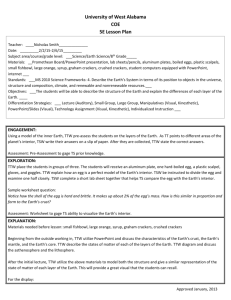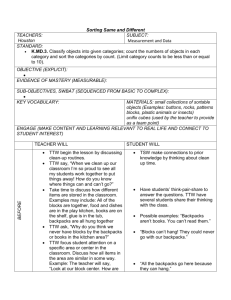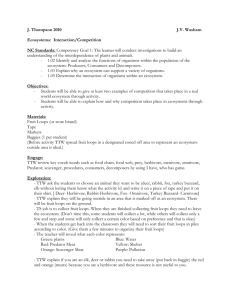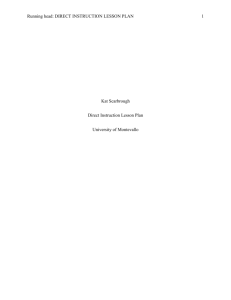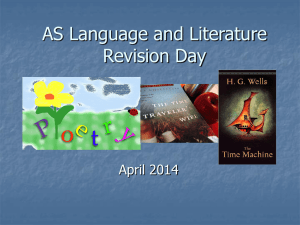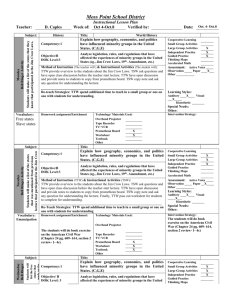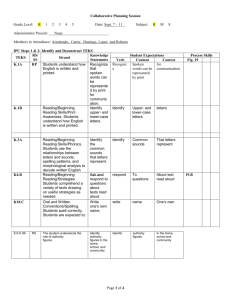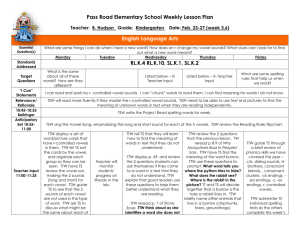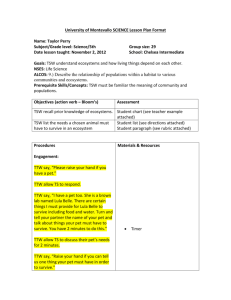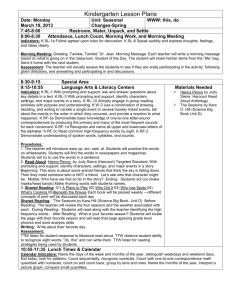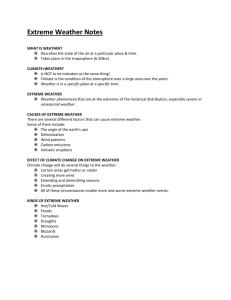Brown_lesson Plan (weather) - Portfolio
advertisement
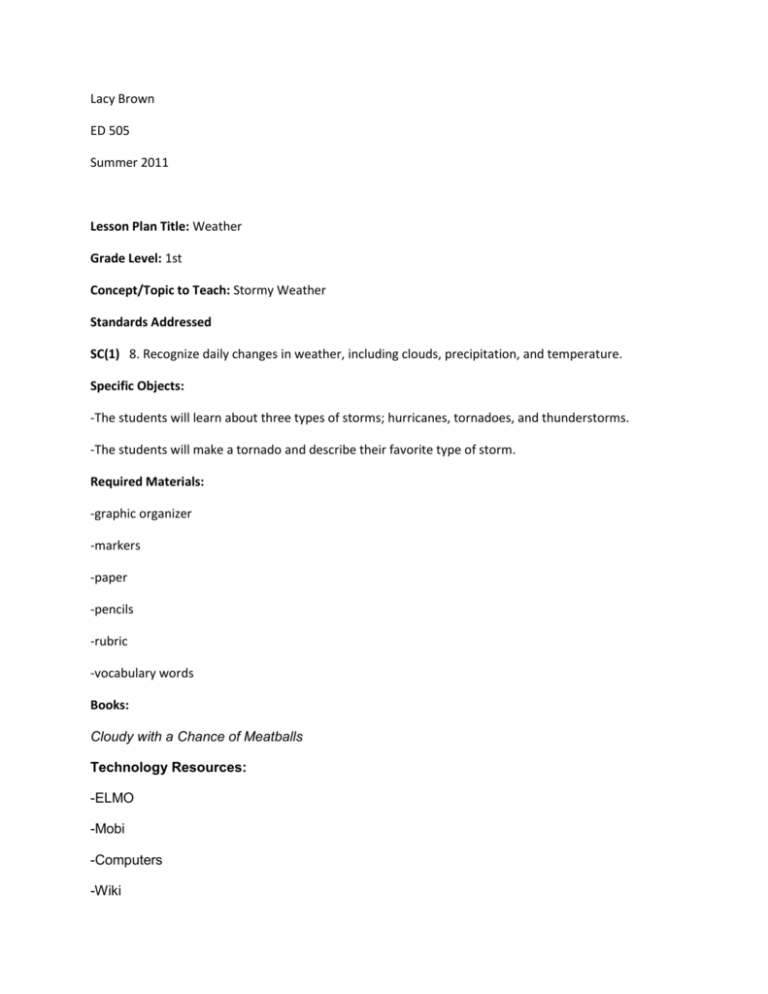
Lacy Brown ED 505 Summer 2011 Lesson Plan Title: Weather Grade Level: 1st Concept/Topic to Teach: Stormy Weather Standards Addressed SC(1) 8. Recognize daily changes in weather, including clouds, precipitation, and temperature. Specific Objects: -The students will learn about three types of storms; hurricanes, tornadoes, and thunderstorms. -The students will make a tornado and describe their favorite type of storm. Required Materials: -graphic organizer -markers -paper -pencils -rubric -vocabulary words Books: Cloudy with a Chance of Meatballs Technology Resources: -ELMO -Mobi -Computers -Wiki Anticipatory Set (Lead In): The Teacher Will (TTW) have weather pictures on the ELMO. TTW ask the students, “Can you tell me what these are pictures of?” TTW go through the different pictures and tell the students what type of storm each picture shows. TTW say. “Today we are going to talk about weather and different types of storms that are created through weather. Before we start, I am going to read you a story called, Cloudy with a Chance of Meatballs. After the teacher finishes the story she will discuss it with the class. TTW say, “In this story, food fell from the sky. When it rains in real life, does food fall from the sky?” TTW ask more questions such as, “Could this story really happen? What type of story Cloudy with a Chance of Meatballs? What are different types of weather do we see?” Step-By-Step Procedures for Teaching the Lesson: TTW have a graphic Organizer displayed on the ELMO. TTW write Tornados, Hurricanes, and Thunderstorms. TTW ask the students what they know about the three storms. As a class they will fill out the graphic organizer. TTW then go over weather terms; meteorologist, tornado, hurricane, thunderstorms, damage, violent, frequent, predict, survive, and gradual. The class will talk about each word and what it means. TTW talk about meteorologist is and what they do in their job. TTW will tell the students that they will make predictions about the weather. TTW then pull up the weather wiki. On the opening pages of the wiki is a weather forecast for the local area. TTW discuss with the students the current weather and weather for the rest of the week. TTW will then begin telling students about hurricanes. TTW show a short clip from the hurricane page. TTW will then discuss hurricanes, how they are made, and how to stay safe during a hurricane. TTW talk about the different category of hurricanes and how they get their names. She will give students a chance to ask questions about hurricanes and then move on to page two of the wiki, thunder and lightning. TTW show a short clip about lightning and then begin talking about the storm. TTW talk about how frequent we see thunder and lightning and how it can form out of nowhere. TTW also discuss how lightning is made and how to stay safe in a thunderstorm. TTW then give students a chance to make lightning strike using the MOBI and the interactive website located on the wiki. TTW give students a chance to ask questions about lightning and then move to the last page on tornadoes. TTW show a short video clip on tornadoes. She will discuss with the class how tornadoes form and how to stay safe during a tornado. She will also discuss the warnings for a tornado with students. TTW will also talk to the students about the different sizes a tornado can be and how they are rated. As a class they will grow an interactive tornado using the link located on the wiki. She will then give students an opportunity to ask questions about tornadoes. Guided Practice/Monitoring: TSW break into three groups. Groups will be formed based on students’ favorite type of storm. Students will create a poster, brainstorming facts about their storm. TSW then (with the help of the teacher) edit the wiki. They will find a picture of their storm and give facts they learned during the weather lesson. Students will then add their facts and picture to the wiki. Students will be graded on this assignment with a rubric. Closure (reflect Anticipatory Set): TTW do a quick review of the lesson. TTW ask, “What are meteorologists? What are tornadoes and what are they made of? What are hurricanes and what are they made of? What is lightning and how is it formed? How do you stay safe during a tornado, hurricane, and thunderstorm? TTW will then go over the weather words again with the class. TSW then present their posters and edits of the wiki to the class. TSW will be also given a participation grade for presenting their topic. Assessment Based on Objectives: TSW be graded on their wiki page. TTW grade them using a rubric. This will show their understanding of the lesson about weather. Students will edit the weather wiki with facts about their storm with 80% accuracy. Adaptations (For Students with Special Needs): The ELL student will be assisted by their ELL teacher. Vocabulary words can also presented with pictures. The ELL students will also be assisted by a peer buddy in their group. Extensions (For Advanced Students): TSW can create their own tornado in a jar. They can also be given their own wiki page and research more in depth facts about the storm. Possible connections to Other Subjects: Vocabulary: learning the definitions of the amazing words Social Studies: Learning about past storms and the damage they left behind. Math: Students can graph the about of hurricanes and tornados from the year and compare them. Art- create a poster of their favorite storm Reading- Cloudy with a Chance of Meatballs is an AR book, and students can take an AR test on the story. Language-Adjectives-Students can describe the different types of storms. Writing-Students can write about their favorite storm and together create a class book. Reflection: The students love this lesson. They really enjoyed the wiki and how they could interact with it and give it their final touch. The students enjoyed the comic relief of Cloudy with a Chance of Meatballs and talking about what food they would like it to rain. Talking about how the different storms formed was a little confusing, but the video clips helped them understand better. This lesson should be followed by more weather lessons in order for students to completely understand the subject of weather. Talking about how to stay safe was a very important part of this lesson because these storms affect our area from time to time. It was important to inform students but not scare them. I believe this was a great lesson and students’ retained a lot of the information.
